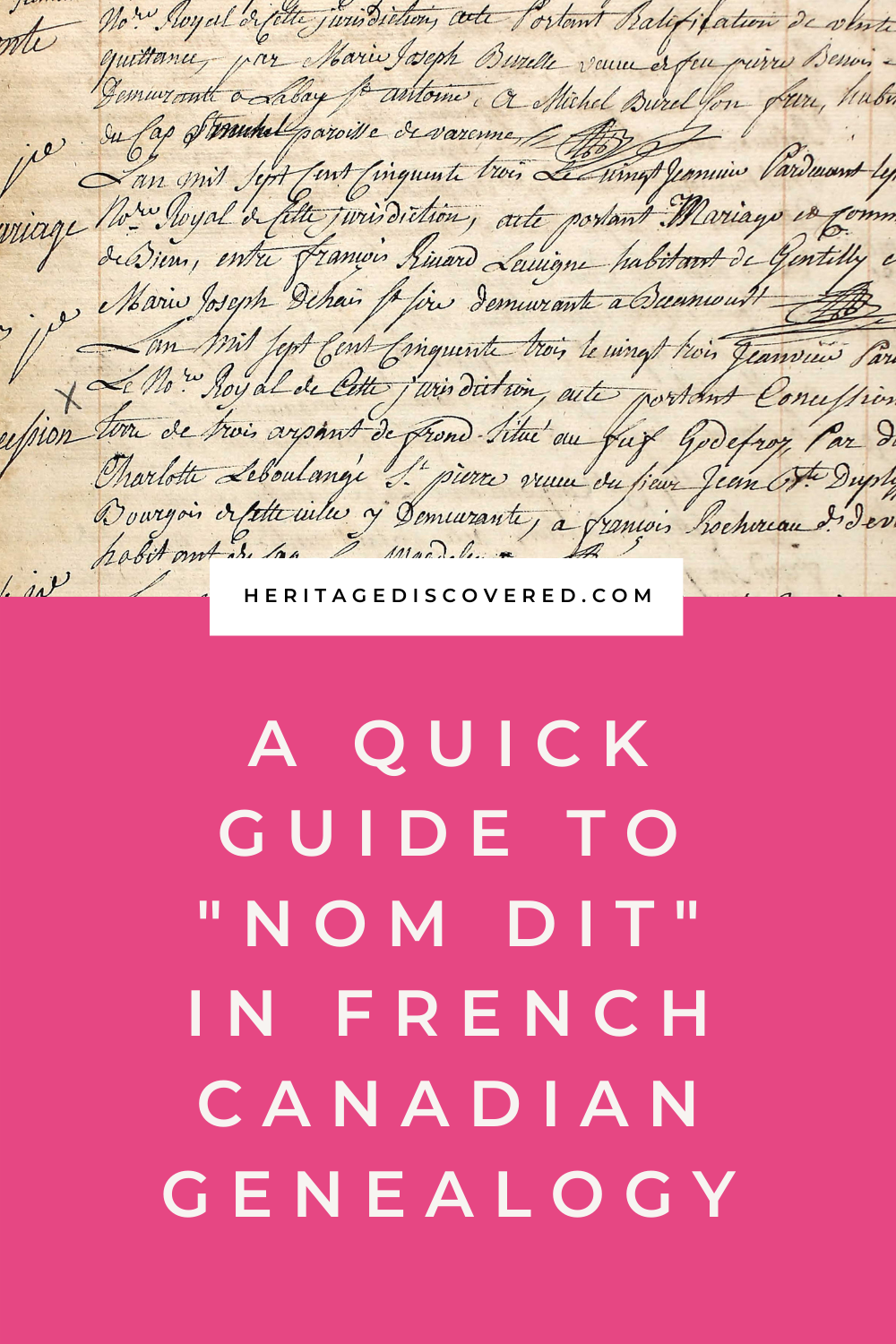What is a nom dit and why did my French Canadian ancestor have one?
*This post may have affiliate links, which means I may receive commissions if you choose to purchase through links I provide (at no extra cost to you). All opinions remain my own.
If you have French Canadian roots, I can almost guarantee you’ll come across someone with a nom dit in your research.
Some of the earliest branches I started researching in my family tree many years ago were my Quebec and Acadian lines. The records on Ancestry made it easier than the branches I had to research by mail.
The further back I went, the more I kept finding strange names, like my Boisvert line turned into De Nevers dit Boisvert. I could not figure out what dit means in French and why these people had two names.
(I also got excited and confused when I learned I was a descendant of many Filles Du Roi, until I figured out I wasn’t really royalty, ha)
Once I understood what these were, my Quebec and Acadian lines became my favorite to search for.
But what is a nom dit?
What is a nom dit, or dit name?
Nom dit means “known as”. The tradition began in France and New France (Quebec) as nicknames to help people tell different families with the same surname apart.
Noms dits were given or adopted in several ways:
Where they were from, like the town, province, or country. Gareman dit Le Picard was from Picardie, Desguise dit Flamand was probably Flemish, Miville dit Le Suisse was from Switzerland.
Where they lived. Dit Lavallee = valley. Dit Lamontagne = mountain.
Their occupations. Dit Bailly = bailiff.
Physical traits. Dit La Jeune = the young. Dit Leblond = blonde. Dit Legros = large.
Personality traits. Dit Ducharme = charming. Dit Belhumeur = good mood. Dit Sanschagrin = without sorrow.
Items in nature. Dit Lafleur = flower. Dit La feuille = leaf.
It’s believed that over 7,500 noms dits were used in Quebec! Because they were so common, don’t be surprised if a good number of people in your tree have a dit name.
Related posts:
9 French Canadian Genealogy Books to Energize Your Research
4 Great Genealogy Resources For US Canada Border Crossing Records
How To Add More Details To Your Family Tree With Passport Applications
What Are Naturalization Records And How Can They Support Your Research?
How to search for French-Canadian ancestors with nom dit
There’s a lot of variation in how these names were used, which can make it trickier to trace your family.
Surnames and dit names were often applied interchangeably. Sometimes people used their surname, sometimes they used the dit name, and sometimes they used their last name with the dit name.
This means in any given record, someone could appear as:
Marcelline Boucher dit(e) Desrosiers
Marcelline Boucher
Marcelline Desrosiers
Marcelline Boucher Desrosiers
Children might adopt the full name with the dit name, and sometimes they used only one or the other. It wasn’t uncommon for a family to use the surname with nom dit for several generations.
Anecdotally, it seems like many people preferred one of the two and usually used that rather than both the surname and nom dit. Often it was the nom dit, especially as time went on.
Eventually, many dit names did become the surname, like my De Nevers dit Boisvert line, which permanently became Boisvert in the mid-1700s.
The practice started to wane around the 1850s, with people choosing one name.
Because people could use one or the other or a surname with a dit name, when researching you do need to search for multiple possible variations because you don’t know which name they might be under for a given record.
It gets even more complicated when both a husband and a wife each had their own dit names as you have to search for more combinations. (Because women didn’t change their maiden name, husbands and wives didn’t share nom dit.)
Like any other genealogy research, be sure to keep spelling variations in mind when searching for the surname and the dit name. For example, Deshaies could also be spelled as Deshayes, Deshais, Dehais, or Dehays.
Related posts:
Why Should You Use Ethnic Newspapers For Genealogy Research?
6 Common Genealogy Mistakes And How To Avoid Them
7 Simple Steps To Creating A Genealogy Timeline (And Why You Need One)
11 Smart Strategies For Searching For Ancestors Who Changed Their Name
Examples of nom dit
There is an incredibly wide variety of dit names you may come across. As mentioned above, they are inspired by everything from nature to personality traits to where they were from.
Because my dad is roughly 70% French-Canadian, I can’t even count all the people with nom dit in my tree!
Some of the more colorful noms dit I have in my family tree are:
Audebout dit Belhumeur
Bourbeau dit Carignan
Barbier dit Minime
Beaufort dit Brunel/Brunelle
Cadieux dit Courville
Carreau dit Lafraicheur
Chauvet dit Quinquenel
Dizy dit Montplaisir
Dubois dit Lafrance
Dussault dit Lafleur
Gareman dit Le Picard
Gaudry dit Bourbonniere
Lemay dit Poudrier
Miville dit Le Suisse
Morin dit Beausejour
Roux dit Sanschagrin
Roy dit La Liberte
Tetreau dit Ducharme
These are a handful of the many nom dit I’ve found so far in my family.
The American-French Genealogical Society has an extensive database of French Canadian surnames, with their noms dit, plus spelling variations to help you match last names with dit names.
Acadian.org also has a list of surnames with spelling variations and associated noms dit.
How to input people with nom dit into family tree software
With all the different variations, you may wonder how to enter ancestors with dit names into your family tree software. That’s going to be based on personal preference, but best practice is to use the complete surname and nom dit.
Over time, the family will adopt one or the other and from then on, you can change the surname in your tree software to reflect that.
To use the De Nevers dit Boisvert line I mentioned in the beginning of this article as an example, only the earliest people in that line are recorded in my tree as De Nevers dit Boisvert. Once they had clearly adopted the name Boisvert permanently, I entered them as such from that point on.
I also use consistently spelling of the names, regardless of how they appear in a document. I keep track of spelling variations in my research notes.
You could also opt to enter whatever surname the person in question used most often or to put the nom dit in an alternate name field.
However you choose to enter them, pick one format and stay consistent with it. Be sure to note spelling variations, as this will help in your searches for that family.
Related posts:
Why Isn’t My Ancestor in the Census?
Everything You Need to Know About Using Home Sources
Why Local History Books Are More Important Than You Think For Genealogy
Final thoughts
Nom dit are nicknames and are very common to find when doing French-Canadian genealogy research.
Nicknames were given or adopted based on a variety of factors like jobs, where they were from, and physical traits.
Searching for ancestors with nom dit can be more challenging because of the many possible variations you have to try. It’s important to identify if your ancestor had one or you may miss valuable records.

